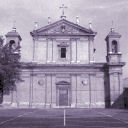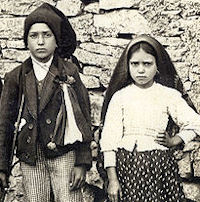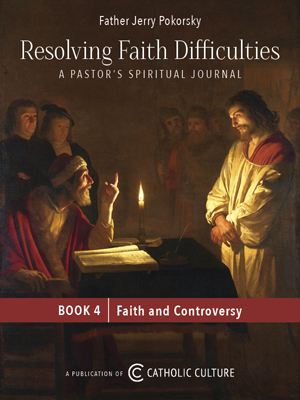Lent: February 20th
Tuesday of the First Week of Lent
Other Commemorations: St. Jacinta Marto (RM)
» Enjoy our Liturgical Seasons series of e-books!
Franciso and Jacinta Marto were officially declared saints of the Catholic Church by Pope Francis on May 13, 2017, in Fatima, Portugal. Today the Roman Martyrology commemorates St. Jacinta (1910-1920), the youngest visionary of Our Lady of Fatima. The brother and sister who tended to their families’ sheep with their cousin Lucia Santo in the fields of Fatima, witnessed the apparitions of Mary, now commonly known as Our Lady of Fatima. Pope John Paul II beatified Francisco and Jacinta May 13, 2000, on the 83rd anniversary of the first apparition of Our Lady at Fatima. Both under 12 years old, they were the youngest non-martyrs to be beatified in the history of the Church. St. Francisco's feast is April 4.
The readings and propers of the Mass shows the Church's constant effort to acquaint us with the teaching of her Founder, and to strengthen us to follow and live his teachings. Mere formalism and externalism are of no value in the religion of Christ. God demands of his people a worship in spirit and in truth, and a conversion which comes from the heart.
Lent is a time set apart to seek the Lord. It is a special time of divine mercy and grace. The Church, acting as God's prophet, calls us to return to the Lord by true penance. The word of God which is sown so abundantly during Lent should grow and bear fruit in us if we have really prepared ourselves by fasting and discipline of the flesh. —St. Andrew Bible Missal
Meditation—Tuesday of the First Week of Lent:
In the liturgical texts for today is hidden the mystery of the Mother of God, intimately connected with that of the incarnation of the Son of God. Let us look at the texts, and begin with the reading from the prophet Isaiah.
So shall my word be that goes forth from my mouth: it shall not return to me empty (55, 11)
When the prophet Isaiah made this affirmation, it was not at all to bring out something merely trivial, but rather a contradiction of what might be expected. For this passage belongs certainly to the story of the passion of Israel, where we read that God’s appeals to his people were continually defeated and that his word invariably remained fruitless, while God appears seated astride history, but not as a conqueror. For everything happened as a sign: the crossing of the Red Sea, the blossoming of the period of the Kings, the return of Israel to their country out of exile, all this now fades away. God’s seed in the world seems to give no results. The prophecy, therefore, however wrapped in obscurity, is an encouragement to all those who, in spite of everything continue to believe in the power of God, convince that the world is not just rocky soil in which the seed cannot find room to grow, but certain that the soil will not always be only a thin layer on the surface from which the birds day by day peck out suddenly what seed has there fallen upon it. (cf. Mk 4,1-9).
For us Christians an affirmation of this kind has the ring of the promised coming of Jesus Christ, thanks to which the word of God has now truly penetrated into the earth and has become bread for us all: seed which bears fruit through the ages, a fruitful response in which God’s discourse has taken root in this world in vital fashion. It is difficult to find elsewhere the mystery of Christ allied to that of Mary in a form as clear and condensed as in the perspective of this promise: for when it affirms that the word, or better the seed, bears fruit, it means to say that it does not fall on the ground to rebound like a ball, but that instead it penetrates deeply into the soil to absorb the moisture there and transform it into itself, truly producing something new, transubstantiating that same earth into fruit. The grain does not remain alone: this is part of the fertility mystery of the earth—Mary, the holy soil of the Church, as the Fathers fittingly call her, belongs to Christ. The mystery of Mary signifies in this connection that the word does not remain alone; rather it assumes the other, the earth, into itself; in the earth of the Mother the word becomes man, and now, mingled with the soil of the whole of humanity, it can return again to God.
The Gospel on the other hand seems to be speaking of something quite different. Here it is a question of our mode of prayer, its correct form, its proper content, the way to comport ourselves, and genuine recollection: not so much therefore of what it is for God to do, but of how we ought to act before him. In reality the two readings are interdependent; we might say that in the Gospel we come now to see how it is possible for human beings to become a fertile field for the word of God. This they can become by preparing those elements by which a life can grow and mature. They attain this end by themselves living from these elements, thus transforming themselves, being impregnated with the word, in the word, immersing their life in prayer and therefore in God.
So this Gospel, then, accords with the introduction to the Marian mystery given by Luke, when in more than one place he says of Mary that she ‘kept’ the word in her heart (2,19; 2,51). Mary united in herself the various currents in Israel; in her prayer she bore within herself the suffering and the greatness of that history, to convert it into a fertile land for the living God. To pray undoubtedly means much more, as the Gospel tells us, than speaking without reflection, merely mouthing words. To be a field for the word means to be earth which allows itself to be absorbed by the seed, which assimilates itself to the see, renouncing itself so as to make the seed germinate. With her motherhood Mary transfused into it her very substance, body and soul, so that a new life might come forth. The saying about the sword which would pierce her soul (Lk 2,35) has a much greater and more profound meaning: Mary makes herself completely available as the soil, she allows herself to be used and consumed so as to be transformed into him, who has need of us in order to become the fruit of the earth.
In the Collect for today we are called upon to have a longing desire for God. The Fathers of the Church maintain that to pray is nothing else than to turn into a longing desire for the Lord. In Mary this petition is heard: she is, may I say, a vessel of desire in whom life becomes prayer, and prayer life. St. John has wonderfully alluded to such a process of transformation while not calling Mary by name in his Gospel. He refers to her solely as the mother of Jesus. She in a certain sense set aside whatever in her life was personal, so as to be uniquely at the disposal of the Son; and it is precisely in this that Mary realised her personality.
I think that such links between the mystery of Christ and that of Mary put before us by today’s Readings are of great importance for the Western activistic mentality, which has reached its peak in our age. For to our way of thinking the principle of domination alone still has value.: action, production, planning the world and, along with that, reconstructing it by ourselves, without owing anything to anybody but confidently relying on our own resources. With such a mentality, then, it is not by chance that we have more and more separated Christ from his mother, without taking account of how Mary as his mother, could signify something indispensable for theology and for faith. The whole of this way of considering the Church thus starts out from an erroneous way of thinking. We may even ourselves consider it as a technical product which we intend to programme cleverly and bring to realization with a tremendous expenditure of energy. We wonder whether that can happen which St. Louis-Marie Grignon de Montfort appended to a passage from the prophet Haggai “You have done much but nothing has come of it” (1,6). “If doing takes the upper hand, becoming autonomous, then those things which are not manufactured, but are living and need to mature, will no longer be able to exist.”
We want to get out of this one-sided outlook belonging to Western activism in order not to degrade the Church to a product of our doing and planning. The Church is not a finished artefact but always living from God, needing to develop and achieve maturity. For this she requires the Marian mystery, just as she herself is the mystery of Mary. She can train herself to that fecundity only if she submits to that sign; only then does she become holy soil for the word. We should adopt the symbol of the fertile soil, we should become people who hope, harvesting their own inner lives, persons who, deep within their prayer, their longing and their faith, make room for growth.
—Cardinal Joseph Ratzinger (Pope Benedict XVI), Journey Towards Easter
St. Jacinta Marto
Between May 13 and October 13, 1917, three children, Portuguese shepherds from Aljustrel, received apparitions of Our Lady at Cova da Iria, near Fatima, a city 110 miles north of Lisbon. At that time, Europe was involved in an extremely bloody war. Portugal itself was in political turmoil, having overthrown its monarchy in 1910; the government disbanded religious organizations soon after.
At the first appearance, Mary asked the children to return to that spot on the thirteenth of each month for the next six months. She also asked them to learn to read and write and to pray the rosary “to obtain peace for the world and the end of the war.” They were to pray for sinners and for the conversion of Russia, which had recently overthrown Czar Nicholas II and was soon to fall under communism. Up to 90,000 people gathered for Mary’s final apparition on October 13, 1917.
Less than two years later, Francisco died of influenza in his family home. He was buried in the parish cemetery and then re-buried in the Fatima basilica in 1952. Jacinta died of influenza in Lisbon, offering her suffering for the conversion of sinners, peace in the world and the Holy Father. She was re-buried in the Fatima basilica in 1951. Their cousin, Lucia dos Santos, became a Carmelite nun and was still living when Jacinta and Francisco were beatified in 2000. Sister Lucia died five years later. The shrine of Our Lady of Fatima is visited by up to 20 million people a year.
—Excerpted from Saint of the Day: Lives, Lessons and Feast by Leonard Foley, O.F.M.; revised by Pat McCloskey, O.F.M.
Patronage: against bodily ills; captives; people ridiculed for their piety; prisoners; sick people; against sickness
Highlights and Things to Do:
- Learn more about St. Jacinta:
- Visit virtually the Shrine of Our Lady of Fatima in Fatima, Portugal.
- Read online Fatima in Lucia's Own Words.
- Catholic Cuisine for some food ideas for St. Jacinta.
 Tuesday of the First Week of Lent
Tuesday of the First Week of Lent
Station with Sant'Anastasia al Palatino (St. Anastasia in the Palatine):
Today's stational church is St. Anastasia in Rome, where, formerly, the Mass of the Aurora on Christmas Day was celebrated. The first church was built in the late 3rd or early 4th century, and was one of the first parish churches of ancient Rome. It was given by a woman called Anastasia and called titulus Anastasiae after her. Later, it was dedicated to the early 4th century martyr St. Anastasia of Sirmium, who is included in the Roman Canon. Pope Francis granted the church to the Syro Malabar Church in July 2020.
For more on Sant'Anastasia al Palatino, see:
For further information on the Station Churches, see The Stational Church.








